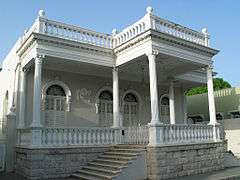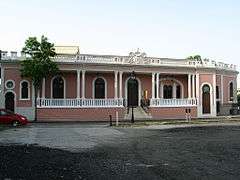Ponce Creole
Ponce Creole is an architectural style created in Ponce, Puerto Rico, in the late 19th and early 20th century. This style of Puerto Rican buildings is found predominantly in residential homes in Ponce that developed between 1895 and 1920. Ponce Creole architecture borrows heavily from the traditions of the French, the Spaniards, and the Caribbean to create houses that were especially built to withstand the hot and dry climate of the region, and to take advantage of the sun and sea breezes characteristic of the southern Puerto Rico’s Caribbean Sea coast.[1] It is a blend of wood and masonry, incorporating architectural elements of other styles, from Classical revival and Spanish Revival to Victorian.[2]
Location

The central district of Ponce in particular is a blend of Ponce Creole and Art Deco: ”The Historic District of Ponce: Second only to Old San Juan in terms of historical significance, the central district of Ponce is a blend of Ponce Creole and Art Deco building styles, dating mainly from the 1890s to the 1930s. One street, Calle Isabel, offers an array of Ponceño architectural styles, which often incorporate neoclassical details. The city underwent a massive restoration preceding the celebration of its 300th anniversary in 1996.”[3]
Origins
Architectural structures of the Ponce Creole style are amongst the 1,046 buildings being restored in Ponce: “The commonwealth has allocated $440 million to restore a 66-block downtown area of 1,046 buildings ranging in style from old Spanish colonial to neoclassical, from "Ponce Créole" to art deco. Many of Ponce's central buildings were erected between the late 1890s and the 1930s, when the city was the hub of the island's rum, sugar cane and shipping industries and was known as La Perla del Sur, the 'Pearl of the South.' It was home to many artists, politicians, and poets.”[4] Today, three styles dominate the architectural landscape in Ponce: neoclassical, Ponce Creole, and Art Deco.[5]
Definition

Ponce Creole is the name given to the architectural style that belongs only in Ponce: “San Juan, the capital, was planned and built by the Spanish conquerors, one writer points out, while Ponce is the work of its native sons, making it a truly authentic Puerto Rican city.” [6]
Characteristics
The Ponce Creole style is characterized by wood and stucco buildings with broad columned porches and balconies and painted in the tasty pinks, peaches, and limes common to hot countries.[7] The style is a blend of Spanish Creole and neoclassical architecture: “In the late 19th century, Ponce developed its own blend of Spanish Creole and neoclassical architecture called Ponce Creole; it's characterized by the use of Corinthian columns, wrought-iron balconies, and gas lamps. It was dubbed Creole because it reminded some of New Orleans's French Quarter. Wealth from Ponce's sugarcane industry financed most of the elegantly ornamented buildings.”[8] Some of the other prominent characteristcis of this architectural style have been described by Pablo Ojeda O'Neill as "a long raised porch, stone rostrium-raised homes to achieve ventilation and to protect the wood foundation, a series of front doors with wooden windows to maximize ventilation."[9]
Architects responsible
While Ponce had many prominent architects during this epoch, such as Manuel V. Domenech and Francisco Porrata Doria, and Alfredo B. Wiechers, Blas Silva distinguished himself in that he actually created a whole new architectural style.[10]
.jpg)
Adapting the curves of the Art Nouveau to the persistent Neo-classicism of Puerto Rico, Silva succeeded in creating a movement in architecture which broke away from the traditional forms while remaining within them. The traditional continuous raised verandah along the front facade is broken up into two and twisted out of its usual linearity into the curved forms preserved today. Characteristic of the architecture to abound in Ponce contemporaneous to Castillo 34, for example, is a profusion of aplique, and eclectic combination and juxtaposition of shapes, particularly curvilinear, and a general ostentation of articulation. The structure at 34 Castillo Street is listed in the National Register of Historic Places.[11]
Blas Silva was probably the most established of the "wedding-cake architects" and was thus sought after mostly by the "nouveau riche" of the period. Silva's houses are among the richest in Ponce, among which the Font-Ubides House (a.k.a. Monsanto Residence) stands out for its circular porches. Other buildings by Blas Silva include the Frau Residence and the Salazar-Candal Residence, both also listed in the NRHP.[12]
Examples
Castillo 34

One example of the Ponce Creole style can be appreciated is Blas’ 1913 design of the Font-Ubides House at Calle Castillo number 34. This residence stands out among the great houses of Ponce for its aggressive incorporation of curvilinear forms and ornament.[13]
Cristina 70
Calle Cristina number 70, commissioned by Ermelindo Salazar and subsequently home to the Museum of Puerto Rican Music and currently headquarters of the Centro Cultural de Ponce Carmen Solá de Pereira, is another example of Ponce Creole architecture. Today, Cristina 70 houses a museum and gallery depicting the various influences on Puerto Rican art.[14] It was designed by Juan Bertoli Calderoni.
Reina 107

The Frau Residence at Calle Reina number 107 is a magnificent example of the architecture of Ponce's aristocracy of the late XIX and early 20th centuries. "This structure is one of the remaining symbols of Ponce's "Golden Period" in which land-owning families lived in the urban core and great immigrations from Europe, Latin America and the other Antilles had turned the originally small settlement into the cultural capital of Puerto Rico. The "Criollo Ponceno" or Ponce Creole architecture to which this building belongs is extremely important in itself since it represents the birth of a high-style native architecture, a hybrid of influences rather than the purely Spanish, or spontaneous vernacular expressions of previous centuries. In particular, the Frau Residence is significant within this genre as it was designed by one of Ponce's most well-known architects, Blas Silva. Silva was particularly well-known among the wealthy classes of the period. His buildings can usually be characterized by what is popularly referred to as wedding-cake architecture of the landed nouyeau riche, for the richness of ornament and detail. Other buildings by Silva include the Monsanto Residence and the Salazar-Candal Residence, both listed in the NRHP."[15]
Isabel 53
The Salazar-Candal Residence located at Calle Isabel 53, but today occupied by the Museo de la Historia de Ponce is one of a group of stylistically eclectic houses built in Ponce between 1900 and 1915. Designed by architect Blas C. Silva in 1911, the building reflects an emerging tendency to incorporate freely disparate and competing architectural motifs. The facade is distinctly rendered in rococo and Moorish detailing to emphasize its bi-functional character as a home and an office respectively.[16]
Marina 27
The "fin de siecle" detailing and wall paintings present a material document of the 19th-century European immigrations to Puerto Rico and the way of life of the landed bourgeois Criollo (Creole) class. In the architecture of Ponce of the period, elements of the Puerto Rican folk dwelling are integrated to Spanish and French-influenced classical detailing, thus resulting in a Ponce-Creole Architecture, of which the Zaldo de Nebot Residence at Calle Marina #27 is a prime example.[17]
See also
References
- ↑ Puerto Rico. By Randall Peffer. Page 225.
- ↑ National Geographic
- ↑ Puerto Rico: The Best Attractions. Frommer’s.
- ↑ Architecture. Welcome to Puerto Rico.
- ↑ Frommer's Caribbean 2008. By Darwin Porter and Danforth Prince. Page 496.
- ↑ The Pearl of the South. American Heritage Magazine.
- ↑ The Pearl of the South. American Heritage Magazine.
- ↑ Admiring architecture in old Puerto Rico. Sunset. February 01, 1993. By Lora J. Finnegan.
- ↑ Neysa Rodriguez Deynes, et al. Breviario sobre la Historia de Ponce y sus Principales Lugares de Interes. San Juan, PR: Model Offset Printing. 1991. Page 54.
- ↑ Mariano G. Coronas Castro, Certifying Official; Felix Juan del Campo, State Historian; and Hector F. Santiago, State Architectural Historian, Puerto Rico Historic Preservation Office. (San Juan, Puerto Rico) August, 1987. In National Register of Historic Places Inventory - Nomination Form. United States Department of the Interior. National Park Service. (Washington, D.C.) Page 3. Listing Reference Number 87001826: Residencia Subira/Residencia Frau. October 29, 1987.
- ↑ Mariano G. Coronas Castro, Certifying Official; Felix Juan del Campo, State Historian; and Hector F. Santiago, State Architectural Historian, Puerto Rico Historic Preservation Office. (San Juan, Puerto Rico) August, 1987. In National Register of Historic Places Inventory - Nomination Form. United States Department of the Interior. National Park Service. (Washington, D.C.) Page 3. Listing Reference Number 87001825: Residencia Font-Ubides. October 29, 1987.
- ↑ Mariano G. Coronas Castro, Certifying Official; Felix Juan del Campo, State Historian; and Hector F. Santiago, State Architectural Historian, Puerto Rico Historic Preservation Office. (San Juan, Puerto Rico) August, 1987. In National Register of Historic Places Inventory - Nomination Form. United States Department of the Interior. National Park Service. (Washington, D.C.) Page 3. Listing Reference Number 87001825: Residencia Font-Ubides. October 29, 1987.
- ↑ Mariano G. Coronas Castro, Certifying Official; Felix Juan del Campo, State Historian; and Hector F. Santiago, State Architectural Historian, Puerto Rico Historic Preservation Office. (San Juan, Puerto Rico) August, 1987. In National Register of Historic Places Inventory - Nomination Form. United States Department of the Interior. National Park Service. (Washington, D.C.) Page 3. Listing Reference Number 87001825: Residencia Font-Ubides. October 29, 1987.
- ↑ Admiring architecture in old Puerto Rico - Ponce, Puerto Rico - Beyond the West. Sunset. February, 1993. By Lora J. Finnegan.
- ↑ Mariano G. Coronas Castro, Certifying Official; Felix Juan del Campo, State Historian; and Hector F. Santiago, State Architectural Historian, Puerto Rico Historic Preservation Office. (San Juan, Puerto Rico) August, 1987. In National Register of Historic Places Inventory - Nomination Form. United States Department of the Interior. National Park Service. (Washington, D.C.) Page 3. Listing Reference Number 87001826: Residencia Subira (a.k.a. Residencia Frau). October 28, 1987.
- ↑ Mariano G. Coronas Castro, Certifying Official; Felix Juan del Campo, State Historian; and Roberto Sackett, State Architectural Historian, Puerto Rico Historic Preservation Office. (San Juan, Puerto Rico) April 11, 1988. In National Register of Historic Places Inventory - Nomination Form. United States Department of the Interior. National Park Service. (Washington, D.C.) Page 3. Listing Reference Number 88000663: Residencia Salazar-Candal. June 9, 1988.
- ↑ Mariano G. Coronas Castro, Certifying Official; Felix Juan del Campo, State Historian; and Hector F. Santiago, State Architectural Historian, Puerto Rico Historic Preservation Office. (San Juan, Puerto Rico) April 8, 1988. In National Register of Historic Places Inventory - Nomination Form. United States Department of the Interior. National Park Service. (Washington, D.C.) Page 3. Listing Reference Number 88000643: Zaldo de Nebot. June 9, 1988.
External links
- ArtDeco en Ponce
- Elements to Bear in Mind on Ponce Architecture. By Jose Ortiz Colom. Instituto de Cultura Puertorriqueña, Ponce Office. November 2007.